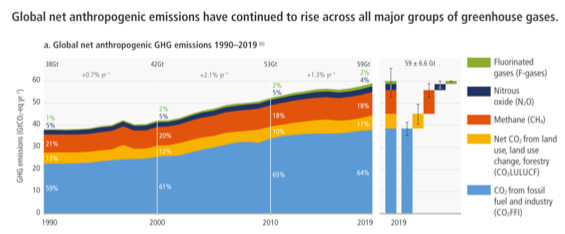

The chances of reaching the "Paris Agreement" are halved
The UN's Intergovernmental Panel on Climate Change (IPCC) Task Force III, Climate Change 2022: Mitigating Climate Change (hereinafter referred to as the "Report"),[1] was released on 4 April 2022 as an important part of the Sixth Assessment Report (AR6), an approximately 2,900-page report prepared by 278 scientists from 65 countries, including 13 Chinese authors. The IPCC uses AR6 to send a clear message – global temperature rise is undoubtedly due to human factors, and we are pushing the limits of climate tolerance and human adaptation. Right now is the most important decade for sustainable climate transition.
The report notes that we still have half the chance of limiting global warming to 1.5°C, but it requires the global greenhouse gas emissions to peak within 3 years, in 2025, and that emissions are 43% lower by 2030 than that of 2019. During the period 2010-2019, net anthropogenic greenhouse gas emissions continued to rise (Figure 1). Average annual greenhouse gas emissions from 2010-2019 were higher than in any previous decade, but the growth rate from 2010 to 2019 was lower than the growth rate from 2000 to 2009, representing a slower rate of greenhouse gas increase.
Figure 1: Global net anthropogenic GHG emission growth (1990-2019)

Net anthropogenic greenhouse gas emissions have increased in all regions of the world since 2010. Due to the raised carbon intensity per GDP, the increase in emissions from industry, power grids, transportation, agriculture and buildings around the world has far outpaced the reduction in carbon dioxide emissions from the effective use of emission reduction technologies. The contribution of global greenhouse gas emissions varies widely from region to region. Differences in regional and national emissions per capita partly reflect different stages of urbanization, with an increasing number of emissions coming from densely populated urban development areas. Households with the highest per capita emissions account for 34-45% of global household greenhouse gas emissions, while the middle 40% contribute 40-53% and the bottom 50% contribute 13-15%.
Since 2010, the cost of major emission reduction technologies has been significantly reduced, which has helped to utilize these technologies globally, especially in developing countries and regions. For example, the price of renewable energy technologies such as wind turbines, solar panels, and electric vehicle batteries is plummeting, while utilization has shown exponential growth over the past 10 years; global energy intensity is on a decline, and from 2010 to 2019, global energy intensity fell by 2% per year, reversing the growth trend of the previous 10 years. Policies addressing technological innovation contribute to the global application and popularization of low-emission technologies, as well as the associated impact of equitable distribution and social responsibility.
The report notes that if emission reduction plans are implemented in accordance with existing Nationally Determined Contributions (NDCs) issued by countries before COP26, global warming in the 21st century could exceed the 1.5°C projected by the Paris Agreement. The implementation of sustainable development policies in the 2020s will be crucial. According to existing global greenhouse gas emission projections, the world will reach carbon peaking between 2020 to 2025 at the latest. Without the strengthening of policies to be implemented by the end of 2020, or if the emission reduction targets are not raised, greenhouse gas emissions are expected to continue to rise beyond 2025, resulting in a median global warming of 3.2°C by 2100. Therefore, in the process to reduce climate change impact, the next ten years of policies will directly affect climate warming, and the report also gives the importance of overall transformation in several emission reduction paths.
Overall transformation: Opportunities to reduce emissions in major industries
Energy transition: Reducing greenhouse gas emissions across the energy system requires rapid and significant transitions, including drastic reductions in overall use of fossil fuels, the deployment of low-emission clean energy technologies, a shift to a renewable-based energy mix, and ways to increase energy efficiency and economy on use. Net zero-emission energy systems require: significant reduction in overall fossil fuel, with the largest amount of fossil fuel use being replaced by clean energy; power systems that do not emit net carbon dioxide; energy-efficient electricity production and transportation; the use of multiple energy carriers such as sustainable biofuels, low-emission hydrogen and derivatives; and extensive electrification of energy systems, including front-end production and back-end usage.
Grid transformation: Electricity systems powered primarily by renewable sources are becoming increasingly viable. While operational, technical, economic, regulatory and policy challenges remain, systemic solutions have emerged to accelerate the adaptation of large amounts of renewable energy in the grid. Ultimately, while challenging, a broad portfolio of options will be required, such as sectoral collaboration, energy storage, smart grids, demand-side management, sustainable biofuels, electrolytic hydrogen, and other technologies to accommodate large amounts of renewables in the energy system. Carbon capture and storage technology (CCS) is also a critical component in future energy transition. Under the premise of using clean energy as much as possible, irreplaceable fossil energy emissions can only rely on CCS technology to reduce its carbon emissions.
Industrial transformation: While net zero carbon emissions from the industrial sector is far from realized, the goals are possible. Reducing emissions from the industry will require concerted action across the value chain, including demand management, energy and material use efficiency and recycling, and transformational changes in emission reduction technologies and production processes in manufacturing. There is an opportunity to achieve net zero GHG emissions for industry through the use of new production processes for low-temperature and zero-greenhouse gas electricity, hydrogen, fuel and carbon management. For the production of base materials (primary metals, building materials and chemicals), many production processes with carbon emissions as low as zero are in the pilot phase, fast approaching commercialization. Reducing emissions from the production and use of chemicals requires a full-life cycle circular economy, including increased plastic recovery, conversion of fuels and feedstocks, and the use of direct carbon capture or CCS technologies where feasible.
Building transformation: Over the past 20 years, direct and indirect emissions from non-residential buildings have increased by about 55% globally, and emissions from residential buildings have increased by about 50%. In the context of continued population growth and continuous increase in per capita floor area, as long as the government and various industries have the will to decarbonize, using increased efficiency and more renewable energy uptake policy options, it is possible to expect existing buildings (after renovation) and buildings in construction to approach net zero greenhouse gas emissions by 2050. In building construction and retrofitting, well-designed and effectively implemented mitigation interventions, both in new and existing buildings, contribute to the achievement of the Sustainable Development Goals in the region, while adapting buildings to future climates and increasing its resilience to disasters.
Transport transition: With temperature rises below 1.5°C, the global transport sector needs to limit emissions growth in developing countries by rapidly reducing emissions from the transport sector in developed countries, reducing carbon emissions by 59% by 2050 compared to 2020. User-focused interventions, such as increasing the use of public transport and the popularization of electric vehicles through changes in public behaviour, can reduce energy demand for the transport sector and support a shift towards more energy-efficient modes of transport. Electric vehicles powered by low-emission electricity offer the greatest potential for decarbonization of road transportation throughout their entire life cycle. Sustainable biofuels can provide additional mitigation benefits for land-based transport in the short and medium term. Sustainable biofuels, low-emission hydrogen and derivatives (including synthetic fuels) can support reducing carbon emissions from shipping, aviation and heavy land transport, but require improved production processes and reduced costs to make it greener and more accessible. Carbon reduction strategies in the transport sector can simultaneously generate a variety of co-benefits, including improved air quality, improved human health, equity in transport services, and reduced congestion.
Conclusion: The most crucial decade
Effective overall transformation is inseparable from the corresponding global, national and regional climate governance policies. Effective and equitable climate governance is based on mutual cooperation and trust between the state and civil society organizations, businesses, youth, labour, the media and local communities. Country leaders need to support climate change mitigation by providing a framework for different stakeholders and a foundation for policy formulation and implementation. The IPCC's Report also hopes that by repeatedly emphasizing the importance of climate reduction policies implemented by the end of 2020, more governments will realize that actions taken now can more effectively change the climate development pathway, accelerate the speed and depth of emission reductions, and reduce the cost and power of subsequent emission reductions.
Note:
[1] IPCC WGIII,Sixth Assessment Report,Climate Change 2022: Mitigation of Climate Change,April 2022. Link:https://www.ipcc.ch/report/ar6/wg3/
Author:Pan Yiren
Translation: Pan Yiren
This article is an original article of the Rock Environment and Energy Institute. Please contact us to obtain the appropriate authorization to reprint. For cooperation and authorization, please send an email to: liying@reei.org.cn
* This article was edited and published by the author in Chinese, because the author accepted an invitation from China Daily.




